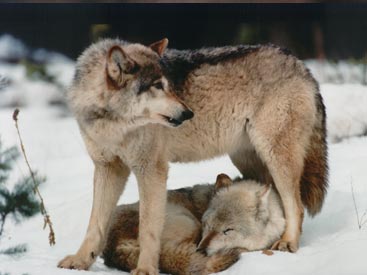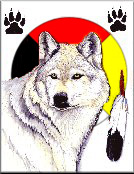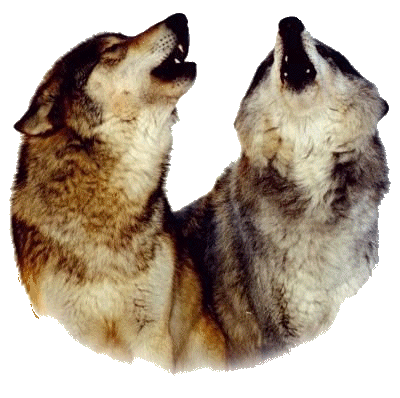January was referred to as wulf-monath in ancient England.
The full moon in January is often called Wolf Moon.
There are three species of wolf the Gray Wolf (Canis lupus), the Red Wolf (Canis rufus)
and the Abyssinian Wolf (Canis simensis).
A wolf's howl is as unique to that wolf as fingerprints are to a human.
The first wolf bounty in the United States was instituted in 1630 in Massachusetts.
The wolf is the largest member of the canine family.
The canid family is made up of 35 living species. Only 8 inhabit North America, these eight are
organized in three general categories: wolves, coyotes, and foxes.
Wolves are often feared and regarded as a threat to humans, more so than their domestic counterparts
- the dog. The dog is responsible for a number of deaths and injuries each year.
Wolves live an average of 8 to 9 years in the wild and 12 to 13 in captivity.
For short spurts, wolves can run up to 28 miles (45 kilometers) per hour. Moving at a trot, they
travel 5 to 10 miles ( 8 to 16 kilometers) in an hour.
Wolves are killed every year from starvation, injuries from prey animals, fighting with other wolves
over territory, falling from rock ledges, drowning in swift rivers, attacks by bears, infections,
natural disaster, disease and man. Man is the greatest enemy to the wolf. Over the years man has
trapped, hunted, poisoned and even run over the wolf with vehicles.
Wolves are susceptible to more than one hundred diseases and parasites. Including roundworm,
tape worm, flatworm, mange, mites, ticks, fleas, distemper, cataracts, oral papillomatosis,
tularemia, bovine tuberculosis, arthritis, cancer, rickets, pneumonia, Lyme disease, and many other
ailments. Rabies is rare in wolves.
Wolves have 42 teeth. Consisting of twelve incisors, four canines, sixteen pre molars, and ten
carnassials and molars.
Wolves generally travel in single file. This eases their trek through snow. Each wolf steps in the
tracks of the wolf ahead of them, creating a path.
Pheromones are discharged from the pores of a wolf's food pads. The paws contain more scent gland
surfaces than any other part of the body.
Wolves also have keen eye sight and are quick to detect the slightest movement of anything in front of
them. Being major predators, their eyes are on the front of there heads, and they have probably a
little less than 180-degree vision, unlike their prey species, which can see over 300 degrees of a
circle. Nighttime vision for wolves is many times better than human vision in the day or night.
Wolves can actually see much better and even much more clearly at night.
The gestation period is 63 days. A litter usually consists of 4-6 pups. Pups weigh about 1 pound at
birth.
The pressure of a wolf jaw is twice that of a German Shepherd at 1500 pounds of pressure per square
inch. Crushing the large bones of their prey is not a problem.
A wolf's paw can be up to 6 inches long. In order to walk better in the snow, one wolf will make the
initial trail and all other wolves will follow by stepping in the original footprints.
Wolves feed mainly on carrion of Caribou, Elk, Deer, Moose. They also will hunt rabbits and rodents.
Wolves can also eat berries, nuts and grass.
The gray wolf - which varies in colors - once roamed over almost the entire northern hemisphere.
A wolf's coat can range from almost pure white to jet black and all of the shades in between.
Wolves do not make good pets.
The skull of the wolf is large and long and tapers forward, averaging nine to eleven inches long and
five to six inches wide.
Wolves have the greatest natural range of any mammal except humans
In a single bound, a wolf can leap 16 feet.
Wolves can run up to 28 miles per hour in short sprints over open terrain and 22 mph for approximately
2 miles. This is slower than most of their prey. Their average pace is about five to nine miles per hour.
A gray wolf stands up to 3 feet ( 90 cm) high and 4 feet long ( 120 cm)
Gray wolves weigh an average of 100 lbs ( 45 kilo) but there are some make it up to 170 lbs.
They use their bushy tail to wrap around the pads of their paws and to protect their nose from the
cold, when they are sleeping.
A wolf family is called a pack. Most wolf packs are a close-knit family with a mother, father, pups,
youngsters and adult offspring.
Wolves are fully grown at 18 months, but females reach maturity at age 2 and males at age 3.
A healthy adult caribou can easily outrun a wolf.
A wolf's territory ranges from 50 to 150 square miles. They leave fresh scent posts, or messages,
marking the boundaries of their territory by urinating.
Many thousands of wolves a year are killed by man. On the other hand, in North America there is no
record of any healthy wolf killing a person.
A wolf can survive on only five deer for an entire season, or twenty for the entire year.
A wolf's general temperament is not vicious. Wolves are not aggressive like some domestic dogs that
have been trained to hunt or to attack. They are emotional animals and are often very shy. When going
after prey, especially with other members of the pack, they can appear very vicious, but a lot of it
is just display and noise.
Wolves almost always avoid people because they are so fearful of them.
Wolves, like other predators, are meat-eaters and have very short digestive tracts. Animal protein
doesn't take very long to digest, but breaking down plant protein can be very difficult. Other animals
such as cows and deer have multi-chambered stomachs and are built for digesting plants much better.
Bears are much stronger and can easily kill wolves.
It's not just a coincidence that wolves look like dogs. Wolves are the ancestors to all dogs, from
poodles to Saint Bernards. Along with foxes and coyotes, they all belong to the family Canidae. Dogs
inherited their body and behavior traits from wolves, yet wolves and dogs are also very different in
many ways. For hundreds of years, dogs have been bred to obey humans. Some dogs have been bred to be
good watchdogs, while others are bred just to be cute and fun. Although wolves are a type of wild dog,
they are nothing more than a distant relative to the domestic dog.
Wolves have incredibly good hearing and can hear sounds up to six miles away, including some
high-pitched sounds that even a human can't hear.
Wolf packs hunt together as a team. The pack combines the strength of many wolves, making it possible
for them to hunt large animals. Statistically wolves are not successful hunters. Many more animals
escape than are caught.
The wolf has developed the capacity to survive in the most inhospitable of climates.
It is not known for sure just when the divergence occurred that split the ancestors of our domestic
dog, Canis familiaris, from the grey wolf, Canis lupus, but it us thought to have occurred about four
million years ago.
The leaders of a wolf pack are the alpha male and the alpha female, often distinguishable by their
raised tails.
A beta male will lower his head and tail when around the alpha pair to let them know he will obey
them.
Subordinates play a strong and important role in helping care for and feed the pups. They are usually
young animals, but occasionally are former alphas who have lost their positions.
In large packs of wolves, there is often a lowest-ranking member who becomes the focus of the pack's
social aggression. Referred to by behaviorists as the "omega" wolf, this animal seems to be a
scapegoat and may actually become an outright outcast. This wolf will keep its fur and ears flattened,
its body close to the ground and its tail often tucked between its legs.
A young adult wolf that has left the pack to find a new, suitable place to live and mate is called a
Lone Wolf.
The nose of the wolf is moist. This helps increase the particles of scent that is absorbed.
Hunger can actually enhance the wolf's sense of smell. In the right atmosphere a wolf can smell prey
from up to one and a half miles away.
Compared to other canines, wolves have longer legs. The foot of the wolf is generally larger than
other canines as well.
A wolf will shed both the underfur and guard hairs in the Spring, by Autumn the coat will be completely replaced.







